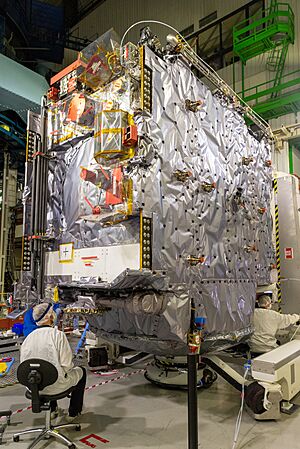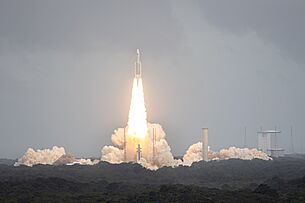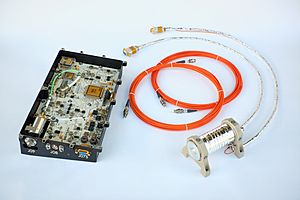Jupiter Icy Moons Explorer facts for kids
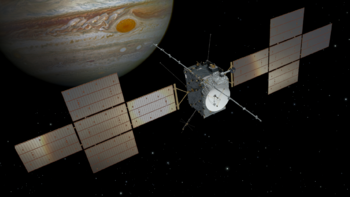
Artist's impression of the Juice spacecraft orbiting Jupiter
|
|
| Names | Juice |
|---|---|
| Mission type | Jupiter orbiter |
| Operator | European Space Agency |
| Mission duration |
|
| Spacecraft properties | |
| Manufacturer | Airbus Defence and Space |
| Launch mass | 6,070 kg (13,380 lb) |
| Dry mass | 2,420 kg (5,340 lb) |
| Dimensions | 16.8 × 27.1 × 13.7 meters |
| Power | 850 watts |
| Start of mission | |
| Launch date | 14 April 2023 12:14:36 UTC |
| Rocket | Ariane 5 ECA+ (VA-260) |
| Launch site | Kourou ELA-3 |
| Contractor | Arianespace |
| Flyby of Moon | |
| Closest approach | 19 August 2024, 21:16 UTC |
| Distance | 700 km (430 mi) |
| Flyby of Earth | |
| Closest approach | 20 August 2024, 21:57 UTC |
| Distance | 6,807 km (4,230 mi) |
| Flyby of Venus | |
| Closest approach | 31 August 2025 |
| Flyby of Earth | |
| Closest approach | 29 September 2026 |
| Flyby of Earth | |
| Closest approach | 18 January 2029 |
| Jupiter orbiter | |
| Orbital insertion | July 2031 (planned) |
| Orbital departure | December 2034 (planned) |
| Ganymede orbiter | |
| Orbital insertion | December 2034 (planned) |
| Orbit parameters | |
| Periapsis | 500 km (310 mi) |
| Apoapsis | 500 km (310 mi) |
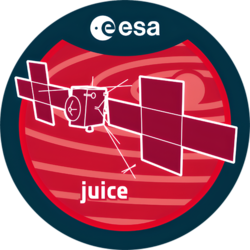 Juice mission insignia Cosmic Vision
|
|
The Jupiter Icy Moons Explorer (called Juice) is a special spacecraft. It is traveling to Jupiter to study three of its icy moons. These moons are Ganymede, Callisto, and Europa. Scientists believe these moons might have huge oceans of liquid water hidden under their frozen surfaces. If they do, these oceans could be places where life beyond Earth might exist.
Juice is the first spacecraft from outside the United States to explore the outer parts of our Solar System. It is also the first mission planned to orbit a moon other than Earth's own Moon. The European Space Agency (ESA) launched Juice on April 14, 2023. It lifted off from the Guiana Space Centre in French Guiana. The main company that built Juice was Airbus Defence and Space. Juice is expected to arrive at Jupiter in July 2031. It will take eight years to get there, using four "gravity assists" to speed up. In December 2034, Juice will start orbiting Ganymede for its main science mission. Another mission, NASA's Europa Clipper, also launched in October 2024.
Contents
Why Explore Jupiter's Moons?
The idea for the Juice mission came from an earlier plan called the Jupiter Ganymede Orbiter. This mission was part of a bigger project that was later canceled. Juice was chosen as a top priority mission for ESA's Cosmic Vision Programme. ESA officially selected Juice on May 2, 2012.
In July 2015, Airbus Defence and Space was chosen to build the spacecraft. It was put together in Toulouse, France. By 2023, the mission was estimated to cost ESA about 1.5 billion euros.
How the Spacecraft Works
Juice was designed to handle tough conditions. It has to deal with being very far from the Sun. This means it relies on large solar panels for power. It also needs to survive Jupiter's strong radiation.
The spacecraft carries about 3,000 kilograms (6,600 pounds) of fuel. This fuel is needed for its journey to Jupiter and to orbit Ganymede. It also helps Juice perform many "flybys" (more than 25!) of different moons.
Juice has a large, fixed antenna that is 2.5 meters (8.2 feet) wide. It also has a smaller, movable antenna. These antennas send data back to Earth. Juice can send about 2 gigabytes of data every day. It can also store a lot of data, up to 1.25 terabytes.
The main engine on Juice uses special fuel. It helps the spacecraft move through space. A thick blanket of insulation keeps the spacecraft at the right temperature. Juice stays stable using special wheels that control its movement. Its electronics are protected from Jupiter's radiation by special shielding.
The science tools on Juice weigh about 280 kilograms (617 pounds). These tools include cameras, spectrometers, and radar. They help study the moons and Jupiter itself. A long, 10.6-meter (35-foot) boom holds some of the instruments. A 16-meter (52-foot) antenna is used for the radar. Other instruments are on the main body of the spacecraft.
Journey to Jupiter
Launch Day
Juice launched into space on April 14, 2023. It rode on an Ariane 5 rocket from the Guiana Space Centre. This was one of the last launches for the Ariane 5 rocket.
The launch was first planned for April 13, 2023. But bad weather caused a delay. The next day, the launch was successful. Juice separated from the rocket and sent a signal back to Earth. Its solar panels then unfolded, showing the launch was a success.
Space Travel Route
Juice is using several "gravity assists" to help it reach Jupiter. A gravity assist is like a slingshot effect. It uses a planet's gravity to speed up the spacecraft.
- Juice flew past the Earth and Moon in August 2024.
- It flew past Venus in August 2025.
- It will fly past Earth again in September 2026.
- A final flyby of Earth is planned for January 2029.
Juice will also cross the asteroid belt twice. There was a plan to fly past an asteroid called 223 Rosa. But this idea was dropped to save fuel for the main mission at Jupiter.
Jupiter Mission Plan
When Juice arrives at Jupiter in July 2031, it will first fly close to Ganymede. This will slow the spacecraft down. Then, it will fire its engines to enter orbit around Jupiter. After that, it will adjust its orbit to match Ganymede's path.
Next, Juice will make several more flybys of Ganymede. These will help it get into the right orbit. It will also make its first flyby of Callisto.
Starting in July 2032, Juice will have two close flybys of Europa. These will be very quick visits. Scientists plan these flybys carefully to limit how much radiation the spacecraft gets. After Europa, Juice will fly past Callisto again.
Juice will then make more flybys of Callisto and Ganymede. This will change its orbit to be more tilted. This tilted orbit will let Juice study Jupiter's polar regions and its magnetic field.
Finally, Juice will use more flybys of Callisto and Ganymede to slow down a lot. In December 2034, Juice will enter orbit around Ganymede. It will first be in a 12-hour orbit. Over time, its orbit will get lower, to about 500 kilometers (310 miles) high. Juice will then spend six months studying Ganymede up close. It will look at what Ganymede is made of and its magnetic field. Towards the end of 2035, Juice will run out of fuel. It is expected to crash onto Ganymede.
What Scientists Hope to Learn
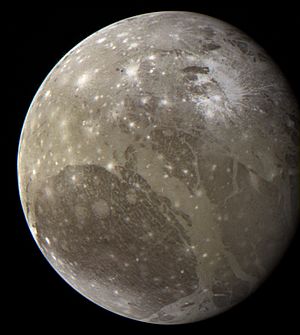
The Juice mission will study Ganymede in great detail. It will also look at Europa and Callisto. Scientists want to know if these moons could support life. They believe all three moons have oceans of liquid water under their icy surfaces. This makes them very interesting places to study.
For Ganymede and Callisto, Juice will try to find out:
- How deep are their hidden oceans?
- What do their surfaces look like?
- What are their icy crusts made of?
- How do their insides work and change over time?
- What is Ganymede's thin atmosphere like?
- How does Ganymede's own magnetic field interact with Jupiter's?
For Europa, Juice will focus on things important for life, like organic molecules. It will also study how features on Europa's surface formed. Juice will use radar to look deep under Europa's ice. This will help find out how thick the ice crust is.
Juice will also observe other smaller moons of Jupiter. It will even look at Io, which has many volcanoes.
Science Tools on Board
ESA chose 11 science instruments for Juice in February 2013. Teams from all over Europe helped build them. The US and Japan also helped with some parts.
- JANUS (Jovis, Amorum ac Natorum Undique Scrutator): This is a camera system. It will take detailed pictures of Ganymede and parts of Callisto. It can take both regular and 3D images.
- MAJIS (Moons and Jupiter Imaging Spectrometer): This tool looks at light to figure out what things are made of. It will study Jupiter's clouds and the ice and minerals on the moons.
- UVS (UV Imaging Spectrograph): This instrument looks at ultraviolet light. It will study the thin atmospheres and auroras of the icy moons. It will also look for plumes (like geysers) on Europa.
- SWI (Sub-millimeter Wave Instrument): This spectrometer studies gases in Jupiter's atmosphere. It also looks at the thin atmospheres and surfaces of the icy moons.
- GALA (Ganymede Laser Altimeter): This tool uses lasers to measure heights. It will map the surfaces of the icy moons. It will also study how Ganymede's shape changes due to Jupiter's gravity.
- RIME (Radar for Icy Moons Exploration): This radar can see through ice. It will study the structures under the surface of Jupiter's moons. It can see up to 9 kilometers (5.6 miles) deep into the ice. After launch, the RIME antenna had trouble unfolding. But after several weeks, it successfully opened on May 12, 2023.
- J-MAG (Juice-Magnetometer): This sensitive tool measures magnetic fields. It will study the hidden oceans of the icy moons. It will also look at how Jupiter's magnetic field affects Ganymede's own magnetic field.
- PEP (Particle Environment Package): This set of six sensors studies the space around Jupiter. It measures different types of particles and gases. This helps scientists understand Jupiter's magnetic environment.
- RPWI (Radio and Plasma Wave Investigation): This instrument studies the plasma (a type of gas) and radio waves around the spacecraft. It uses special probes and receivers to do this.
- 3GM (Gravity and Geophysics of Jupiter and Galilean Moons): This radio science package helps study gravity. It will measure the gravity fields of Ganymede and the other icy moons. This helps figure out how big their internal oceans are. It also studies the atmospheres of Jupiter and its moons.
- PRIDE (Planetary Radio Interferometer and Doppler Experiment): This experiment uses radio signals from Juice. These signals are picked up by telescopes on Earth. This helps scientists make very precise measurements of the gravity fields of Jupiter and its moons.
More to Explore
- Exploration of Jupiter
- Europa Clipper
- Galileo – a past Jupiter orbiter
- Juno – a current Jupiter orbiter
- Tianwen 4 – a planned mission to Jupiter and Callisto
- List of European Space Agency programmes and missions
See also
 In Spanish: Jupiter Icy Moons Explorer para niños
In Spanish: Jupiter Icy Moons Explorer para niños


